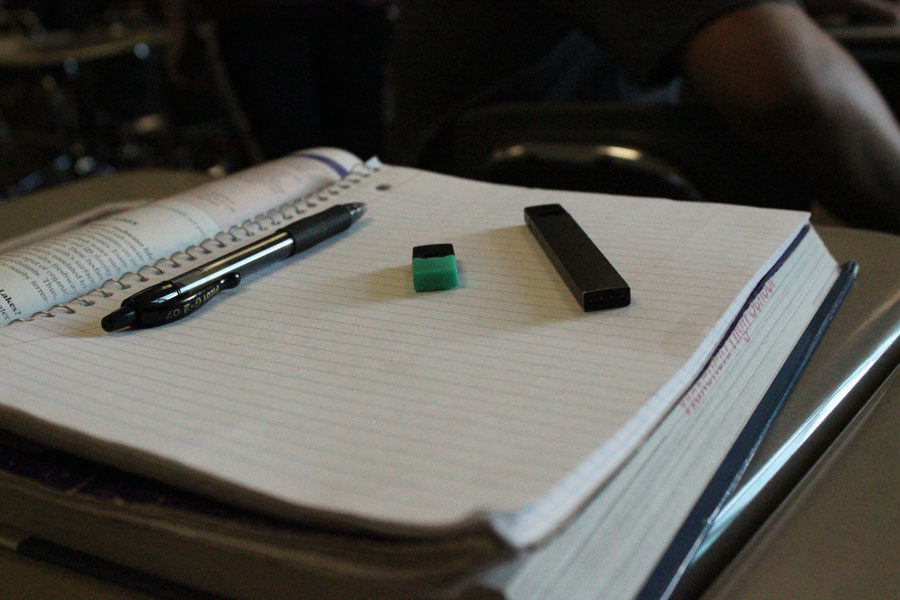Juuls entice younger audiences
A Juul Device (right) and a Juulpod (center) look undetectable on an average student’s notebook.
December 5, 2017
For decades, studies from the U.S Department of Health and Human Services show adolescents have been habitually smoking tobacco daily. The same study showed that the daily use of cigarettes by adolescents has decreased in recent years. As technology has changed in the past decade, adolescents have moved on to alternate methods of consuming nicotine. This started with E-cigarettes and vaporizers and has moved onto the Juul, a vaporizer that has found popularity among students at Wakefield.
Juul is a brand of vaporizers designed to be used as an alternative to cigarettes. Juuls stand out from typical e-cigarettes and vaporizers due to their compact design and lack of a strong scent. Students prefer smoking Juuls because their discreet design allows them to hide in plain sight, due to the fact they look similar to a USB stick. Because of its design, some students have gotten brazen enough to smoke a Juul during class time, either in the restroom, or the classroom. Spanish Teacher, Mr. Bowman has caught many students in the act.
“I tend to use the student restrooms from time to time, so it’s coincidental,” Bowman said. “It’s easy to see when they’re doing it because of the smoke. I had one student that actually did it during class and you notice it for the same reasons. It seems to be a problem.”
Juuls themselves aren’t much better than cigarettes. According to its website (juulvapor.com), each Juul pod contains 0.7mL of liquid with 5% nicotine, which is equivalent to one pack of cigarettes. Nicotine can be highly addictive, especially among teens, and is difficult to quit (according to betatobaccofree.hhs.gov). To gain further insight about Juul use at Wakefield, we interviewed two students who use Juuls often and we will refer them as Anonymous A and Anonymous B to keep their identities confidential.
Anonymous A is over 18 years old and is legally able to purchase Juuls at any local gas station. He has been using Juuls since March of this year.
“I like what it does to me, I need it,” Anonymous A said. “ If I go more than an hour without it, I go crazy
Anonymous B is under 18 years old, gets Juuls from friends, and has been using Juuls for a year. Anonymous B also claims that he is not addicted to using Juul and that it doesn’t affect his school work.
“It makes me feel good, but I don’t use it on a daily basis,” Anonymous B said. “I don’t Juul in school.”
Smoking Juuls can also be an expensive habit with Juul devices costing $34.99 and a four pack of Juul pods being $15.99. Anonymous B goes through 4 pods a week and has spent $300 on their Juul habit. Anonymous A stated that they go through eight pods, equivalent to eight pack of cigarettes a week, and has maybe spent $2000 on Juul products so far.
Many students also tend to use Juuls in their cars in the parking in the morning or during lunchtime. While this may not be in the classroom or school hallways, this act of using Juuls in the school parking lot is still punishable as it’s being done on school property.
According to Wake County’s policies on tobacco products, it states: “The use or display of any tobacco product by any person in school buildings, school facilities or school vehicles; on school campuses; and in or on any other school property owned, operated or contracted for by the school system is prohibited.”
The general opinion of whether or not if Juuls are bad are still being disagreed upon. Regardless of their effects, they are still prohibited in school and they can be a distraction in learning in school environments. When students bring Juuls or any other tobacco products, they must expect the potential consequences that they bring.
“Most behavior is controlled or influenced through incentives [to Juul] or deterrents,” Bowman said. “The best way to incentivize better behavior, in this case, would be for the school to come up with a stricter policy against it.”















